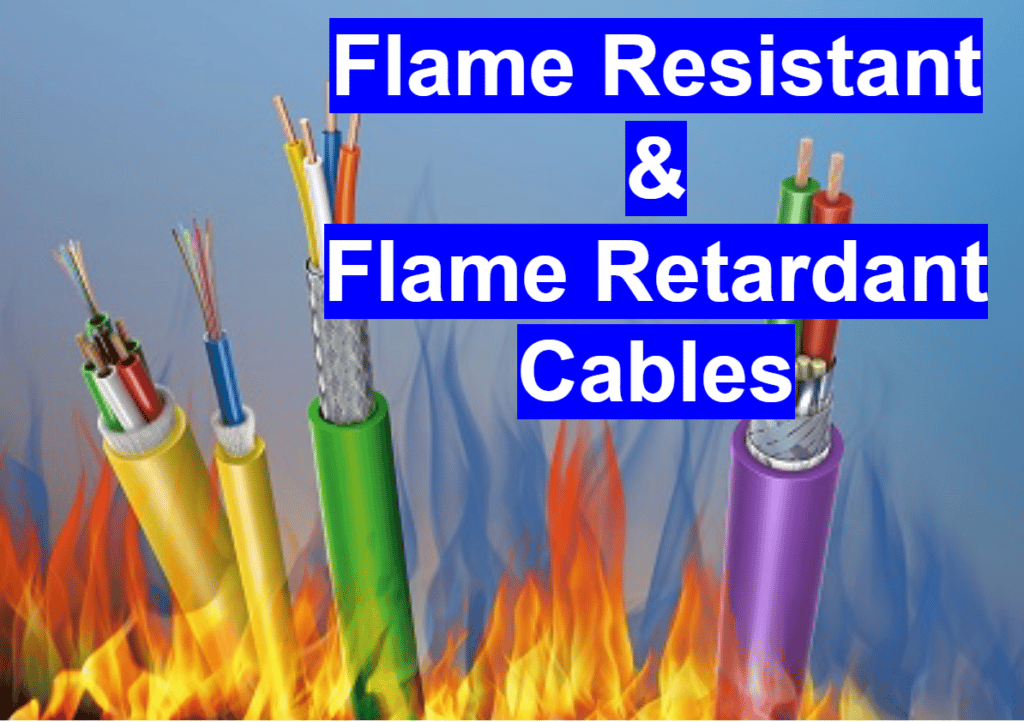In this post, we will discuss the difference between flame-resistant and flame-retardant cables. The cables are widely used for the transmission of power and signals. The cables are the backbone of the electrical system.
There should be no vulnerability to cables in the case of fire. Therefore, we need to ensure fire safety for cables. Fire safety is very essential because if fire safety is not taken care of, then it can be hazardous for human life as well as the nearby environment. Hence, two major types of fire safety cables are used. Types of cables are flame-resistant cables and flame-retardant cables.
Flame-resistant cables are made of a material which is inherently resistant to catching fire (that is, flame-resistant is self-extinguishing). Flame-resistant cable does not melt or drip when exposed directly to extreme heat.

Flame-retardant cables are made from a material which has been chemically treated to self-extinguish in the fire.
Flame retardant and flame-resistant cables perform the same function but they behave differently in the event of a fire.
Flame Resistant Cables
Flame-resistant cables continue to operate and do not burn during the event of any fire. Flame-resistant cables also do not melt and would resist high temperatures. Because of this property, the flame-resistant cable result into preventing itself from burning in case of fire. The flame-resistant cable can typically survive temperatures of up to 300 degree Centigrade.
Flame-resistant cables need to pass the tests as per the defined standards of the IEC (International Electrotechnical Commission). Flame-resistant cables pass the tests as per IEC 60331 (IEC 60331 specifies tests for electric cable for circuit integrity under fire conditions). Flame resistant cables are designed to maintain circuit integrity and are capable to work continuously for a specified amount of time. It means the flame-resistant cable can resist a specified amount of fire for short period of time.
Flame resistant cables are used for critical circuits where the temperature of the surroundings is more. The critical circuits usually operate on energized to trip or on the energize to operating principle.
One such example of the circuit is where the circuit needs to operate during a fire in an instrument cable for fire fighting equipment such as a deluge valve or a solenoid valve. Flame resistant cable can be used for safe evacuation and in emergency services.
Flame-resistant cable has a red-coloured outer sheath (also called a jacket).
Flame Retardant Cables
Flame retardant cables will continue to operate in case of fire, but they resist the fire and burn very slowly. Flame-retardant cables prevent the fire from spreading by reducing the amount of heat that is released from a fire. This way, the flame retardant cable also reduces the potential for the fire to spread. Hence, flame retardant cables suppress the process of combustion.
Flame retardant cables are not rated to continue their operation during fire events. But flame retardant cables would resist the propagation of the fire into a new area due to their behaviour in the fire. Flame retardant cables need to pass the tests as per IEC 60332, BS EN 60332, EN 50265, and BS 4066. Flame-retardant cables serve an important purpose for the instrument loops that operate in fail-safe mode.
Flame-retardant cables have grey-coloured or black-coloured outer sheaths (also called jackets).
Major Differences Between the Flame Resistant and the Flame Retardant Cables
| Flame Resistant Cables | Flame Retardant Cables |
| Flame resistant cables do not catch the fire. | Flame retardant cables catch the fire. But flame retardant cables works by slowing the fire and does not allow flame to spread quickly in the surrounding. |
| Flame resistant cables do not prevent the spread of fire to the nearby surroundings. | Flame retardant cables prevent the propagation of the fire to nearby areas. |
| The outer sheath of the flame resistant cables is always red in colour | The outer sheath of the flame retardant cables is always black or grey in colour. |
| Flame resistant cables are used when we do not want the cable to be destroyed in case of fire. | Flame resistant cables are used when we do not want the fire to spread quickly in the nearby surroundings. |